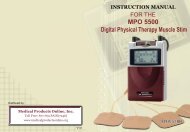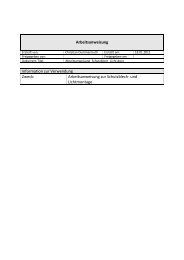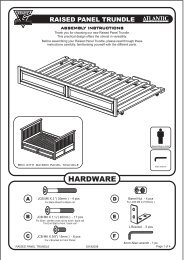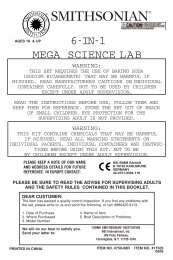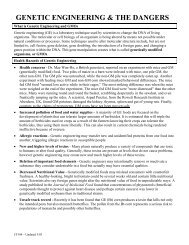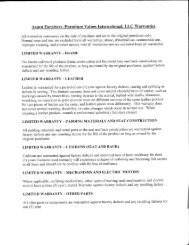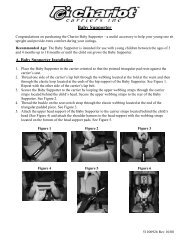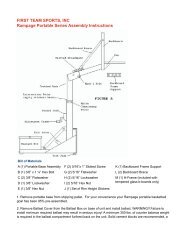New SunWize Grid-Tie Systems
New SunWize Grid-Tie Systems
New SunWize Grid-Tie Systems
Create successful ePaper yourself
Turn your PDF publications into a flip-book with our unique Google optimized e-Paper software.
Addendum: Best Practices<br />
Addendum<br />
Steps-to-Success: Residential Installation<br />
Introduction<br />
While the steps involved in residential and commercial PV installation are virtually identical, what transpires within each step is significantly<br />
different. Residential and commercial installations are like apples and oranges, but both require disciplined progression through<br />
a progress where steps must be followed in sequence and not short-cut or skipped. This document examines each step in more detail<br />
for residential installations, often highlighting common pitfalls as well as proven practices. It is intended as a companion and contrast to<br />
Steps-to-Success: Commercial Installation.<br />
Lead Generation<br />
The key to every residential solar installation business is to have a steady volume<br />
of incoming leads keeping the “funnel” full. Leads come from three general sources:<br />
referrals, promotion (e.g. advertising, PR, events), and networking (e.g. Chamber,<br />
general contractors, and architects). Referrals are the highest quality lead and<br />
should represent 50% of all new business.<br />
Common Pitfall: Many installers do not proactively follow-up with their<br />
customers. They do not take measures to systemically ensure that their customers<br />
are satisfied and an active source of referrals.<br />
Proven Practice: Successful installers cultivate referral business through a wide<br />
range of practices that include yard signs, referral fees, testimonials, homeowner<br />
solar parties and tours.<br />
Lead Qualification<br />
Once a residential lead comes in, it needs to be quickly and carefully evaluated over<br />
the phone in terms of its potential. Common criteria to qualify leads include electricity<br />
usage, orientation, shading, roof type, building height, budget, and timing.<br />
Common Pitfall: A frequent mistake made by installers is to inadequately qualify a<br />
prospect in the haste to schedule a site visit. Site visits to unqualified candidates<br />
are a significant waste of resources. Also, many installers fail to follow-up on leads<br />
in a timely manner; leads should be called back within 12-24 hours.<br />
Proven Practice: In addition to having a checklist of criteria, successful installers use a web-based, satellite mapping application like<br />
Google Earth to make a preliminary assessment of the solar potential of a home. Reviewing design options and costs while on the phone<br />
can also prove valuable in qualifying and progressing homeowners in the sales cycle.<br />
Site Evaluation<br />
Successful site evaluation entails: initially establishing rapport with the homeowner(s) and then gathering the information needed to complete<br />
a design and proposal. Both take time and rigor to do well. Site visits should last 1½ to 2 hours and should never be omitted.<br />
Common Pitfall: Many installers make the error of not collecting the data they need to accurately complete a design and proposal. Typically,<br />
this entails not getting on the roof and taking proper measurements, performing a shade analysis when applicable or examining the<br />
electrical service. Often installers do not discuss conduit runs and equipment locations, particularly in regard to aesthetic considerations.<br />
Proven Practice: Most successful companies take an educational approach to selling, making sure their customers understand the<br />
basics of solar and the system they are purchasing. A critical objective is to establish trust and confidence by understanding the homeowner’s<br />
situation and providing the information they need to make informed decisions that realistically serve their goals.<br />
Customer Proposal<br />
The proposal is a crucial tool in closing the deal. In addition to the system description (preliminary design) and contractual details, it<br />
needs to make a simple and compelling case for purchasing a solar system while accurately depicting the performance and financial<br />
return of the system. It should also serve to differentiate and position the installation company.<br />
Common Pitfall: Many installers neglect the economics of solar, not clearly showing financial benefits such as savings, payback, and returnon-investment.<br />
Successful installers accurately portray the expected performance of the system and the anticipated economic benefits.<br />
Proven Practice: Successful installers use home-grown templates or solar proposal software to shorten the time to generate a professional<br />
proposal.<br />
Financing<br />
A number of projects fail to move forward because homeowners require some form of financing. Upfront cost is still one of the biggest<br />
hurdles to solar adoption. Successful installers familiarize themselves with a variety of consumer loan alternatives available to the industry,<br />
including refinancing, HELOCs, property assessment type loans (currently limited to certain states and cities), unsecured solar and<br />
home improvement loans, bridge loans and solar leases.<br />
Common Pitfall: Installers often fail to communicate loan options to their prospects or the impact of interest payments on the economics<br />
of the system.<br />
continued<br />
142



